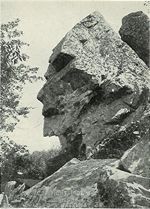Massasoit
Massasoit (c. 1581 – 1661) was the sachem (leader) of the Wampanoag people and a key figure in the early history of the Plymouth Colony in present-day Massachusetts, United States. His role in ensuring the survival of the Pilgrims and the establishment of a peaceful and cooperative relationship between the Wampanoag and the colonists during the first Thanksgiving has been celebrated in American folklore and history.
Early Life and Leadership[edit | edit source]
Massasoit was born around 1581, though the exact date and place of his birth are not documented. As the sachem of the Wampanoag, he inherited a network of alliances and tributary relationships with other Native American groups, which he sought to maintain and expand throughout his leadership. His name, Massasoit, means "Great Leader" in the Wampanoag language.
First Contact with Pilgrims[edit | edit source]
In March 1621, shortly after the arrival of the Pilgrims aboard the Mayflower, Massasoit established contact with the settlers. Recognizing the potential for an alliance that could strengthen his position against rival tribes and the encroaching European settlers, Massasoit negotiated a peace treaty with the Pilgrims. This treaty, which promised mutual protection and support between the Wampanoag and the Plymouth settlers, was crucial for the survival of the early colony.
The First Thanksgiving[edit | edit source]
Massasoit is often credited with saving the Pilgrims from starvation during their first winter in the New World. In the autumn of 1621, after a successful harvest, the Pilgrims invited Massasoit and his people to celebrate what is now considered the first Thanksgiving. This event symbolized the cooperation and friendship between the Wampanoag and the Pilgrims, although the peace would be tested in the years to come.
Later Years and Legacy[edit | edit source]
Massasoit's later years were marked by increasing tensions between the Native American tribes and the growing number of English settlers. Despite these challenges, he continued to advocate for peace and diplomacy until his death in 1661. His sons, Wamsutta and Metacom (also known as King Philip), succeeded him as leaders of the Wampanoag, but they faced even greater challenges as English expansion continued.
Massasoit's legacy is complex. While he is remembered for his crucial role in the early survival of the Plymouth Colony and his efforts to foster peace, the subsequent history of Native American and European relations in New England was marked by conflict and displacement. His story is a reminder of the complicated and often tragic history of contact and colonization in the Americas.
Search WikiMD
Ad.Tired of being Overweight? Try W8MD's physician weight loss program.
Semaglutide (Ozempic / Wegovy and Tirzepatide (Mounjaro / Zepbound) available.
Advertise on WikiMD
|
WikiMD's Wellness Encyclopedia |
| Let Food Be Thy Medicine Medicine Thy Food - Hippocrates |
Translate this page: - East Asian
中文,
日本,
한국어,
South Asian
हिन्दी,
தமிழ்,
తెలుగు,
Urdu,
ಕನ್ನಡ,
Southeast Asian
Indonesian,
Vietnamese,
Thai,
မြန်မာဘာသာ,
বাংলা
European
español,
Deutsch,
français,
Greek,
português do Brasil,
polski,
română,
русский,
Nederlands,
norsk,
svenska,
suomi,
Italian
Middle Eastern & African
عربى,
Turkish,
Persian,
Hebrew,
Afrikaans,
isiZulu,
Kiswahili,
Other
Bulgarian,
Hungarian,
Czech,
Swedish,
മലയാളം,
मराठी,
ਪੰਜਾਬੀ,
ગુજરાતી,
Portuguese,
Ukrainian
Medical Disclaimer: WikiMD is not a substitute for professional medical advice. The information on WikiMD is provided as an information resource only, may be incorrect, outdated or misleading, and is not to be used or relied on for any diagnostic or treatment purposes. Please consult your health care provider before making any healthcare decisions or for guidance about a specific medical condition. WikiMD expressly disclaims responsibility, and shall have no liability, for any damages, loss, injury, or liability whatsoever suffered as a result of your reliance on the information contained in this site. By visiting this site you agree to the foregoing terms and conditions, which may from time to time be changed or supplemented by WikiMD. If you do not agree to the foregoing terms and conditions, you should not enter or use this site. See full disclaimer.
Credits:Most images are courtesy of Wikimedia commons, and templates, categories Wikipedia, licensed under CC BY SA or similar.
Contributors: Prab R. Tumpati, MD





